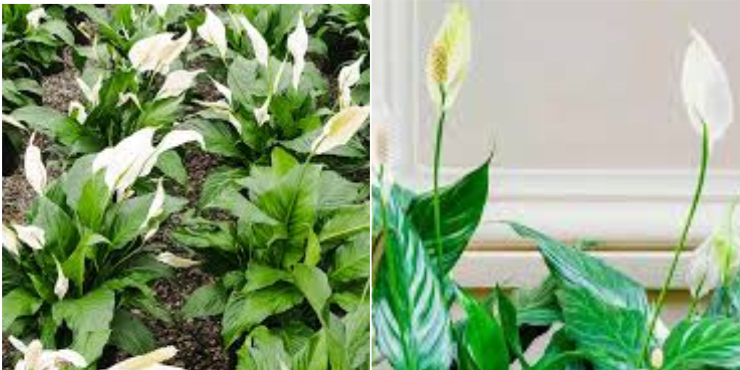Peace Lily Turning Brown If you’re a proud owner of a peace lily, you may have encountered the frustrating problem of its leaves turning brown. Don’t worry, you’re not alone. Many plant enthusiasts have faced this issue, and fortunately, there are several possible causes and solutions to help you revive your beloved peace lily. In this comprehensive guide, we will explore the most common reasons behind a peace lily turning brown and provide you with practical tips to restore its health. So, let’s dive in and unravel the mystery of the browning peace lily leaves.
Understanding the Peace Lily Turning Brown
Peace Lily Turning Brown Before we delve into the troubleshooting process, let’s take a moment to understand the peace lily (Spathiphyllum wallisii). Native to tropical regions of the Americas, peace lilies are known for their lush green foliage and elegant white flowers. They are popular indoor houseplants due to their ability to thrive in low light conditions and their air-purifying qualities.
Possible Causes of Peace Lily Turning Brown

1. Overwatering or Underwatering
Peace Lily Turning Brown One of the most common reasons for a piece lily’s leaves turning brown is improper watering. Excessive watering may result in root rot, whereas insufficient watering can lead to dehydration in the plant. Both conditions can stress the plant and result in browning leaves. To determine if your peace lily is overwatered or underwatered, check the soil moisture level and adjust your watering routine accordingly.
2. Incorrect Light Exposure
Peace lilies prefer bright, indirect light. Exposing them to direct sunlight can scorch their leaves and cause browning. On the other hand, inadequate light can also lead to leaf discoloration. Find a suitable location for your peace lily where it can receive the right amount of light without being directly exposed to the sun.
3. Temperature and Humidity Fluctuations
Peace Lily Turning Brown thrives in average room temperatures between 65-80°F (18-27°C). Drastic temperature changes or prolonged exposure to cold drafts can cause stress and lead to brown leaves. Additionally, peace lilies require a humid environment. Dry air can result in leaf browning, especially during winter when indoor heating reduces humidity levels. You can enhance humidity by employing a humidifier or positioning the plant on a tray containing water and pebbles.
4. Chemicals in Water
Tap water often contains chemicals like chlorine and fluoride, which can be harmful to peace lilies. These chemicals can accumulate in the soil, affecting the plant’s health and causing leaf browning. To counter this, allow tap water to sit overnight or use filtered water to water your peace lily.
5. Fertilizer Issues
Over-fertilizing or using the wrong type of fertilizer can cause the tips and edges of peace lily leaves to turn brown. Follow the recommended fertilization schedule and use a balanced, water-soluble fertilizer specifically formulated for houseplants. Avoid applying fertilizer directly to dry soil, as it can burn the roots and lead to leaf discoloration.
6. Pest Infestation
Pests like spider mites and mealybugs can infest peace lilies, causing stress and browning of leaves. Inspect your plant regularly for signs of pests, such as webbing, tiny insects, or sticky residue on the leavesAddress any infestations promptly by applying natural insecticidal soap or neem oil to combat the issue.
Solutions to Revive a Peace Lily Turning Brown

Now that we have identified the potential causes, let’s explore some solutions to revive your peace lily and restore its vibrant green foliage.
1. Adjust Your Watering Routine
Evaluate your watering habits and adjust them according to your peace lily’s needs. Ensure that the soil is slightly moist but not waterlogged. Ensure thorough watering of your plant, permitting any surplus water to escape from the pot. Empty the saucer to prevent the plant from sitting in standing water. Remember, consistency is key when it comes to watering your peace lily.
2. Provide Adequate Lighting
Position your peace lily in an area where it can bask in gentle, indirect sunlight, taking care to protect it from direct sun exposure, particularly during the peak hours of the day. If you notice your peace lily leaning towards a light source, rotate it periodically to promote even growth.
3. Maintain Optimal Temperature and Humidity
Peace Lily Turning Brown in a room with temperatures between 65-80°F (18-27°C)Steer clear of subjecting it to chilly drafts or abrupt temperature variations.. Increase humidity levels by using a humidifier or employing other methods such as misting the leaves or placing the plant on a water-filled tray with pebbles.
4. Use Filtered Water
To avoid chemical buildup in the soil, use filtered water or allow tap water to sit overnight before watering your peace lily. This will help eliminate harmful chemicals and ensure the well-being of your plant.
5. Follow a Proper Fertilization Schedule
Administer a well-balanced, water-soluble fertilizer at a diluted concentration every 4-6 weeks throughout the plant’s active growth phase. Always adhere to the fertilizer’s instructions to prevent excessive fertilization. Remember to water your peace lily before applying fertilizer to prevent root burn.
6. Combat Pest Infestations
If you discover pests on your peace lily, isolate the plant to prevent the infestation from spreading. Eliminate observable pests by gently swabbing them with a cotton swab soaked in rubbing alcohol. For severe infestations, treat the plant with organic insecticidal soap or neem oil according to the manufacturer’s instructions.
Preventing Future Issues
Prevention is key to maintaining a healthy peaceful lily. Below are a few recommendations to ensure the flourishing of your plant:
- Regularly dust the leaves to allow them to absorb maximum light.
- Ensure that your peace lily is positioned away from drafts and air conditioning vents that may expose it to cold temperatures.
- Maintain a consistent watering routine and avoid overwatering or underwatering.
- Monitor the humidity levels in your home and use a humidifier if needed.
- Inspect your plant regularly for signs of pests and take immediate action if you spot any.
By following these preventive measures, you can minimize the chances of your peace lily developing brown leaves and ensure its long-term health.
Conclusion
Peace lily turning brown can be alarming, but with proper care and troubleshooting, you can revive your plant and restore its beauty. Remember to adjust your watering routine, provide appropriate lighting, maintain optimal temperature and humidity, use filtered water, follow a fertilization schedule, and combat any pest infestations. By incorporating these practices into your plant care routine, you can enjoy a flourishing peaceful lily with vibrant green foliage. So, don’t give up on your brown-leafed peace lily – revive it with love and attention!


